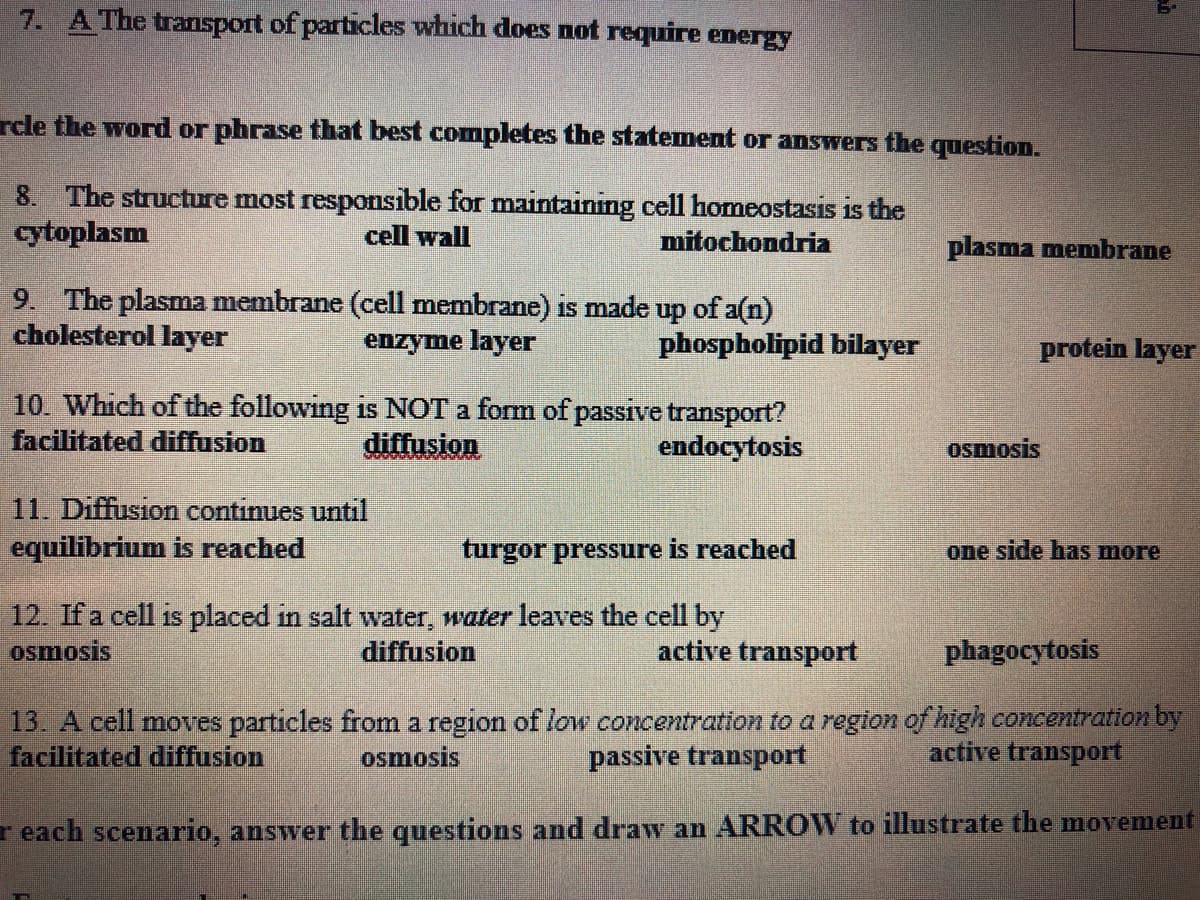8. The structure most responsible for maintaining cell homeostasis is the cytoplasm cell wall mitochondria plasma membrane 9. The plasma membrane (cell membrane) is made up of a(n) cholesterol layer enzyme layer phospholipid bilayer protein layer 10. Which of the following is NOT a form of passive transport? facilitated diffusion diffusion endocytosis osmosis 11. Diffusion continues until equilibrium is reached turgor pressure is reached one side has more 12. If a cell is placed in salt water, water leaves the cell by osmosis diffusion active transport phagocytosis 13. A cell moves particles from a region of low concentration to a region of high concentration by facilitated diffusion osmosis passive transport active transport
8. The structure most responsible for maintaining cell homeostasis is the cytoplasm cell wall mitochondria plasma membrane 9. The plasma membrane (cell membrane) is made up of a(n) cholesterol layer enzyme layer phospholipid bilayer protein layer 10. Which of the following is NOT a form of passive transport? facilitated diffusion diffusion endocytosis osmosis 11. Diffusion continues until equilibrium is reached turgor pressure is reached one side has more 12. If a cell is placed in salt water, water leaves the cell by osmosis diffusion active transport phagocytosis 13. A cell moves particles from a region of low concentration to a region of high concentration by facilitated diffusion osmosis passive transport active transport
Concepts of Biology
1st Edition
ISBN:9781938168116
Author:Samantha Fowler, Rebecca Roush, James Wise
Publisher:Samantha Fowler, Rebecca Roush, James Wise
Chapter3: Cell Structure And Function
Section: Chapter Questions
Problem 11RQ: The tails of the phospholipids of the plasma membrane are composed of _____ and are _____? a....
Related questions
Question
Circle the words or phrase that best completes the statement or answers the question

Transcribed Image Text:7. A The transport of particles which does not require energy
rde the word or phrase that best completes the statement or answers the question.
8. The structure most responsible for maintaining cell homeostasis is the
cytoplasm
cell wall
mitochondria
plasma membrane
9. The plasma membrane (cell membrane) is made up of a(n)
cholesterol layer
enzyme layer
phospholipid bilayer
protein layer
10. Which of the following is NOT a form of passive transport?
facilitated diffusion
diffusion
endocytosis
osmosis
11. Diffusion continues until
equilibrium is reached
turgor pressure is reached
one side has more
12. If a cell is placed in salt water, water leaves the cell by
diffusion
osmosis
active transport
phagocytosis
13. A cell moves particles from a region of low concentration to a region of high concentration by
facilitated diffusion
osmosis
passive transport
active transport
r each scenario, answer the questions and draw an ARROW to illustrate the movement
Expert Solution
This question has been solved!
Explore an expertly crafted, step-by-step solution for a thorough understanding of key concepts.
This is a popular solution!
Trending now
This is a popular solution!
Step by step
Solved in 2 steps

Knowledge Booster
Learn more about
Need a deep-dive on the concept behind this application? Look no further. Learn more about this topic, biology and related others by exploring similar questions and additional content below.Recommended textbooks for you

Concepts of Biology
Biology
ISBN:
9781938168116
Author:
Samantha Fowler, Rebecca Roush, James Wise
Publisher:
OpenStax College

Human Biology (MindTap Course List)
Biology
ISBN:
9781305112100
Author:
Cecie Starr, Beverly McMillan
Publisher:
Cengage Learning

Human Heredity: Principles and Issues (MindTap Co…
Biology
ISBN:
9781305251052
Author:
Michael Cummings
Publisher:
Cengage Learning

Concepts of Biology
Biology
ISBN:
9781938168116
Author:
Samantha Fowler, Rebecca Roush, James Wise
Publisher:
OpenStax College

Human Biology (MindTap Course List)
Biology
ISBN:
9781305112100
Author:
Cecie Starr, Beverly McMillan
Publisher:
Cengage Learning

Human Heredity: Principles and Issues (MindTap Co…
Biology
ISBN:
9781305251052
Author:
Michael Cummings
Publisher:
Cengage Learning